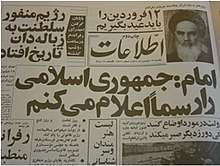Ettela'at
Ettela'at (Persian: اطلاعات lit. Information) is a Persian language daily newspaper published in Iran. It is among the oldest publications in the country, and the oldest running Persian daily newspaper in the world.[1] The paper has a conservative stance[2] and focuses on political, cultural, social and economic news.[3] Until the revolution of 1979, the newspaper was associated with its chief founder Abbas Masoudi (1895-1974).[4]

 Newspaper's Logo | |
| Type | Daily |
|---|---|
| Format | Print, online |
| Owner(s) | Iran Chap Organisation |
| Founder(s) | Abbas Masoudi |
| Publisher | Iran Chap Organisation |
| Editor | Mohmoud Doai |
| Founded | 10 July 1926 |
| Political alignment | Conservative |
| Headquarters | Tehran, Iran |
| Website | www.ettelaat.com |
History and profile
Ettala'at was started in 1926.[5] The circulation of the paper was 15,000 copies during the reign of Reza Shah.[5]

On 6 January 1978 an article appeared in Ettela'at suggesting Ayatollah Ruhollah Khomeini was a British agent serving colonialism.[6] The next day, clerics in Qom protested and the police demanded they disperse. When they refused, police opened fire and at least twenty people were killed. Iranian media displayed outrage, which increased tensions leading up to the 1979 Iranian Revolution.[6]
On 31 January 1979, Kayhan and Ettela'at papers announced that Khomeini would return from Paris the other day. Ettela'at's title was "tomorrow morning at 9, visiting Imam in Tehran." The news led to the flow of millions of people from different cities to Tehran.[7] In 1979, the newspaper published Firing Squad in Iran, a photo showing Kurdish militants being executed by Iranian authorities. The photo would later go on to win the 1980 Pulitzer Prize, attributed to "Anonymous," but later was revealed in 2006 to be photographer Jahangir Razmi.
See also
References
- Parvin 1998, pp. 58-62.
- Arash Karami (15 March 2014). "Iran's Fourth Estate". Asharq Al Awsat. Retrieved 22 September 2014.
- Abdolrasoul Jowkar; Fereshteh Didegah (2010). "Evaluating Iranian newspapers' web sites using correspondence analysis". Library Hi Tech. 28 (1): 119–130. doi:10.1108/07378831011026733.
- Handelman-Baavur, Liora (2019). Creating the modern Iranian woman : popular culture between two revolutions. Cambridge: Cambridge University Press. p. 61. ISBN 978-1-108-62799-3. OCLC 1127288640.
- Mushira Eid (1 January 2002). The World of Obituaries: Gender across Cultures and over Time. Wayne State University Press. p. 52. ISBN 0-8143-3655-8. Retrieved 13 September 2014.
- Sandra Mackey (1996) The Iranians: Persia, Islam and the Soul of a Nation. Plum Penguin Group. New York, NY. p.278 ISBN 0-452-27563-6
- "11 Bahman 1357, tomorrow morning at 9, visiting Imam in Tehran".
Sources
- Parvin, Nasserddin (1998). "EṬṬELĀʿĀT". Encyclopaedia Iranica, Vol. IX, Fasc. 1. pp. 58–62.CS1 maint: ref=harv (link)
| Wikimedia Commons has media related to Ettela'at. |